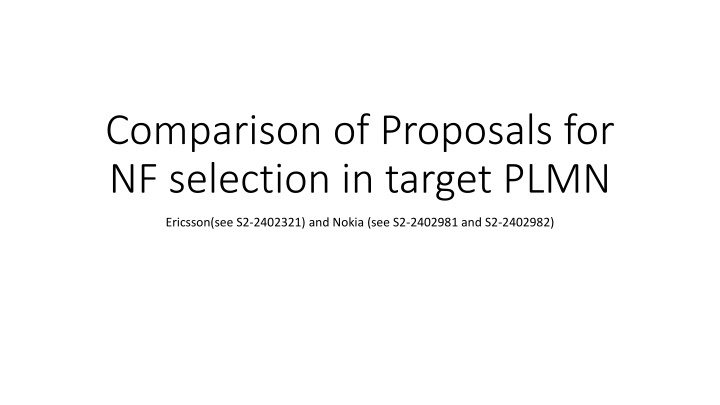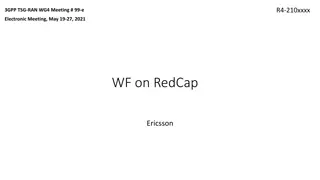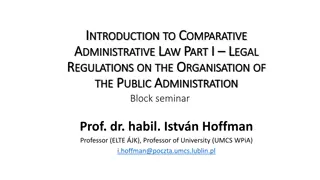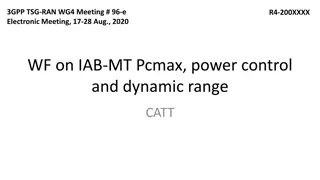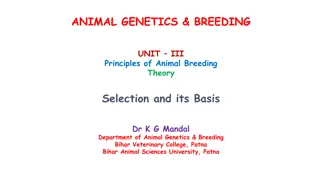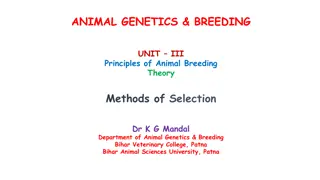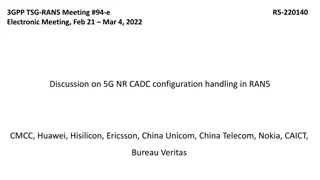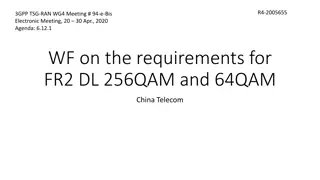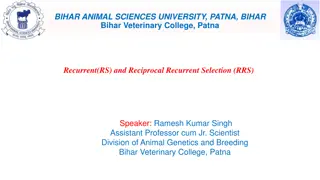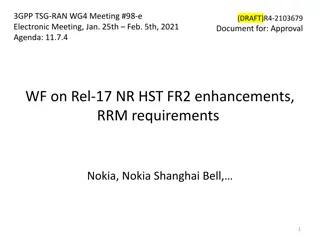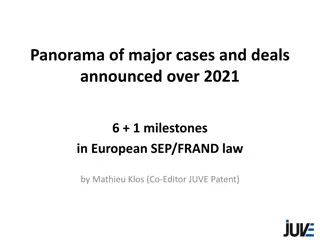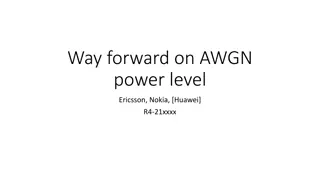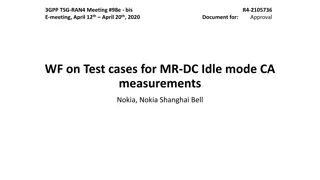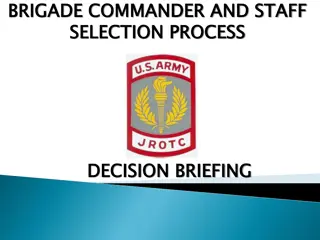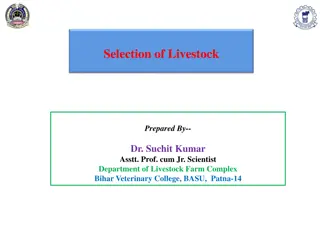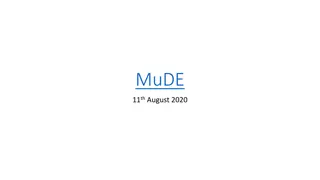Comparison of NF Selection Proposals by Ericsson and Nokia
The comparison between NF selection proposals by Ericsson and Nokia focuses on the ability of the target PLMN to use indirect communication with SCP for NF selection. This includes different communication models, NF profiles, and service requests in the context of NF selection in target PLMN. Nokia's proposal emphasizes operator policies and related capabilities to facilitate NF selection in both local and remote PLMNs.
Download Presentation

Please find below an Image/Link to download the presentation.
The content on the website is provided AS IS for your information and personal use only. It may not be sold, licensed, or shared on other websites without obtaining consent from the author.If you encounter any issues during the download, it is possible that the publisher has removed the file from their server.
You are allowed to download the files provided on this website for personal or commercial use, subject to the condition that they are used lawfully. All files are the property of their respective owners.
The content on the website is provided AS IS for your information and personal use only. It may not be sold, licensed, or shared on other websites without obtaining consent from the author.
E N D
Presentation Transcript
Comparison of Proposals for NF selection in target PLMN Ericsson(see S2-2402321) and Nokia (see S2-2402981 and S2-2402982)
Common Target: Target PLMN should be able to use indirect communication (models C or D) with SCP in target PLMN performing NF selection (e.g. based on load, capacity) Discovery A B C o n s u m e r P r o d u c e r C o n s u m e r P r o d u c e r NRF Different Communication Models possibel in different PLMN (see Annex E in TS 23.501) NF profile(s) Service Request Service Request Service Response Service Response Subsequent Request Subsequent Request Discovery C D NRF NRF NF profile(s) C o n s u m e r P r o d u c e r C o n s u m e r P r o d u c e r Service Request + parameters Service Request Service Request Service Request Response Response SCP SCP Subsequent Request Subsequent Request
Common Target: NF selection in Target PLMN Indirect communication with SCP in target PLMN Source PLMN Target PLMN SCP(s) Network: (with/without delegated discovery, For inbound requests) Request sbi-discovery-* (WITH del. disc) Request sbi-discovery-* (WITH del. disc) To target or to Intermediate SCP SEPP SEPP Any communication model (direct, indirect with/without delegated discovery) For Model D, the source PLMN does not need to obtain the NF profiles from target PLMN For Model C, the NFp profiles are required in the source PLMN to performed initial selection
Nokia proposal (S2-2402981 and S2-2402982) Based on operator's policy and support of related capabilities indicated by the NRF in the local PLMN, the NRF in the remote PLMN may return an indication that indirect communication with delegated discovery with NF (re)selection at target PLMN (Model D in Annex E with SCP in target PLMN doing NF (re)selection) and/or indirect communication without delegated discovery with NF (re)selection at target PLMN (Model C in Annex E with SCP in target PLMN doing NF (re)selection) is requested and for delegated discovery in target PLMN omit NF profiles. NF service Consumer NF service Producer NRF SCP NRF 1. Nnrf_NFDiscovery Request PLMN-1 PLMN-2 2. Nnrf_NFDiscovery_Request/ Response 3. Nnrf_NFDiscovery Response If no Indication of NF selection in Traget PLMN is provided 4. Selection 5. Request If Indication of NF selection in Traget PLMN is provided 6. Request (discovery & selection parameters) 7. Nnrf_NFDiscovery_Request/ Response 8. Selection 9. Request Based on operator s policy and configuration, the NRF in the local PLMN may also determine without interaction with the NRF in the remote PLMN that indirect communication with delegated discovery with NF (re)selection at target PLMN is requested for communication for that remote PLMN. NF service Consumer NF service Producer SCP NRF SCP NRF PLMN-1 PLMN-2 1. Request (discovery & selection parameters) 2. Nnrf_NFDiscovery Request 3. Nnrf_NFDiscovery_Request/ Response 4. Nnrf_NFDiscovery Response Request for NF selection in target PLMN is propagated from NRF in local PLMN to NF consumer or SCP in local PLMN. If no Indication of NF selection in Traget PLMN is provided 5. Selection 6. Request The service request is sent to an SCP in target PLMN with appropriate discovery headers, and that SCP performs NF (re)selection. If Indication of NF selection in Traget PLMN is provided 7. Request (discovery & selection parameters) 8. Nnrf_NFDiscovery_Request/ Response 9. Selection 10. Request
Ericsson proposal (S2-2402321) Source SCP determines whether delegation should be done to the target PLMN, based on the Target PLMN delegation capabilities. Source PLMN-1 Target PLMN-2 Source PLMN-1 Target PLMN-2 SEPP SEPP SEPP SCP SEPP With delegated discovery: if delegation is possible, then the source SCP does not perform NRF discovery but forwards the request to the target network where initial selection and reselection is performed PLMN2 delegation capability Get Inter-PLMN delegation capabilities PLMN2 delegation capability exchange Without delegated discovery: if delegation is possible, the source NF needs to performs initial selection anyway (then NRF discovery is required). The source SCP forwards the request with target NF instance or NF Set or both, and therefore initial selection or reselection is delegated to the target PLMN. Inter-PLMN delegation capabilities are config in target SEPP, are provided to the source SEPP Source SCP gets inter-PLMN delegation capabilities from Source SEPP WITH delegated discovery WITHOUT delegated discovery NF service Producer NF service Consumer NF service Producer NF service Consumer NRF SCP NRF SCP SCP NRF SCP NRF 1. Nnrf_NFDiscovery Request 3. Nnrf_NFDiscovery Response 1. Request (discovery & selection parameters) (WITH delegated disc) PLMN-1 PLMN-2 PLMN-1 PLMN-2 2. Nnrf_NFDiscovery_Req/Resp 2. Nnrf_NFDiscovery Request 4. Initial Selection 5. Request (discovery & selection parameters) (WITHOUT delegated disc) Source SCP does not support Inter-PLMN delegation 3. Nnrf_NFDiscovery_Req/Resp 4. Nnrf_NFDiscovery Response 5. Selection 6. Request 6. Request 7. Request 7. Request Source SCP does not support Inter-PLMN delegation Reselection if required Reselection if required PLMN-2 supportsIndirect Communication WITH or WITHOUT delegated discovery PLMN-2 supportsIndirect Communication WITH delegated discovery 3. Request (discovery & selection parameters) (WITH delegated disc) 2. Check Inter-PLMN delegation capabilities 6. Check Inter-PLMN delegation capabilities 7. Request (discovery & selection parameters) (WITHOUT delegated disc) Source SCP supports Inter-PLMN delegation Source SCP supports Inter-PLMN delegation 4. Initial selection 8. Initial selection 5. Request 9. Request Reselection if required Reselection if required
Comparison of impacts Ericsson Nokia SEPP impacted YES New service proposed (to be defined in SA2 since this is related to signalling routing not to security) New interaction SEPP-SEPP NO NRF impacted NO YES New parameters in NRF Discovery request and response Source NRF to target NRF communication required (if delegation to target is applicable) YES (for Model C, to obatin NF profiles) NO (for Model D) If option to configure source NRF is used for model D : NO Otherwise: YES (see Discussion point 2) Source NRF to target NRF communication required (if delegation to target is NOT applicable) YES YES New configuration required Target SEPP (SCP does not need to be configured, but functionality is enabled per PLMN with enhanced SCPs) If option to configure source NRF is used: Source NRF Otherwise: Target NRF (see Discussion point 2) Behavior if new capabilities are not supported Fallback to existing behavior with NF selection in source PLMN (How source SEPP can determine that target SEPP does not support new interaction is still beeing invetigated) Fallback to existing behavior with NF selection in source PLMN
Discussion point 1: For Communication Model B in source PLMN: Should NF consumers support delegated (re)selection in target PLMN Communication? Currently included as option in Nokia proposal and excluded in Ericsson proposal, but both proposals could be adjusted. Pro: Enables support of deployments with Communication Model B in source PLMN Con: Updates of NF consumer required for requests to other PLMN: Determine target PLMN requirements for indirect commincation (via NRF or SEPP) Supply appropriate information (e.g. discovery headers) in request to enable indirect communication Ericsson Nokia NFc is impacted YES NF gets Inter-PLMN capability from SEPP YES NF discovery via NRF is impacted
Discussion point 2: Negotiation of communication model between Source and Target PLMN or configuration in source PLMN? Currently both variants included as options in Nokia proposal and negotiation assumed in Ericsson proposal, but both proposals could be adjusted. Pro Negotiation: More flexibility in negotiation and possibly less configuration (if different target PLMNs have different requirements about NF selection) Pro Configuration in source PLMN: Less Inter-PLMN procedures (might be sufficient should operator community agree on communication model applicable for inter-PLMN communication)
